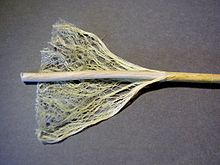Fiber digestion
In the natural fiber industry , fiber digestion refers to the separation of the fibers from the rest of the plant as well as the separation or refinement of the fiber bundles into individual fiber bundles or their collectives (less often into individual fibers). With bast fibers, this is done by breaking and rolling the stems, in which the woody inner part can be separated from the outer fibers. Mechanical (for wood pulp ) or chemical pulping processes (for pulp ) are used for pulping wood fibers for paper production .
Fiber digestion of hemp and flax
The fiber breakdown of hemp and flax can be used to obtain long or short fibers . After harvesting, the hemp and flax straw is laid out in parallel to obtain long fibers ( longitudinal fibers ) and dried. Drying is followed by roasting and renewed drying in the field. The straw, which is still lying parallel, is then broken and the long fibers are extracted by swinging and panting the straw. Shives from the broken wood core as well as tow and super short fibers or dust are produced as by-products of the long fibers .
Short fibers are produced in modern digestion systems and optimized for technical use. To pre-treat the fiber breakdown of the short fiber and total fiber line, the hemp straw is cut and roasted in the field and then pressed into round and square bales; water roasting as with traditional long fiber processing is not required. These are fed to a fiber disintegration system in random layers ( random fibers ) and opened. The straw is then broken in the crushing units, which consist of toothed rollers of different sizes , to enable the fibers and the wood core to be separated (deforestation). In contrast, newer technologies work according to the so-called impact principle. The natural bond between fiber and non-fiber components is broken down according to the principles of impact, pressure and shear stress.
Over several steps, the wood components are as shives separated from the fibers, wherein the teilentholzte straw by preopener, cleaners, Vorauflöser and finally shaking and needle opening units out and becomes dissolved into smaller fiber bundles. The fiber bundles are further broken up and refined into individual fibers via further stage cleaning, rollers, carding devices and opening units. The number and sequence of these cleaning and opening devices depend on the principle of primary digestion used in each case (crusher or impact digestion) and the intended use of the final products of the process.
Fiber breakdown in wood
→ Main article: wood digestion
When pulping wood fibers for the paper industry , chemical or mechanical processing methods are used, depending on the purpose of the paper. With mechanical pulping, wood pulp ( wood pulp ) is produced for so-called wood -containing paper. The wood is sanded into fibers by pressing it against a rotating grindstone. An alternative mechanical variant is to shred wood chips under heat and pressure between two rotating disks (thermomechanical pulp, TMP).
The most common chemical pulping process used to produce pulp is the sulfate process . The raw material is boiled in a lye that is suitable for almost all types of wood. The sulphite process , in which the cooking liquid is very acidic, is particularly suitable for spruce wood . The cooking process removes lignin , which acts as the natural binding agent in the wood. This increases the lifespan and archival stability of the paper. Paper that is made from 100 percent cellulose is called wood-free paper.
literature
- Ivan Bócsa, Michael Karus, Daike Lohmeyer: The hemp cultivation. Botany, varieties, cultivation and harvest, markets and product lines. 2nd edition, Landwirtschaftsverlag GmbH, Münster 2000.
- Michael Carus et al .: Study on the market and competitive situation for natural fibers and natural fiber materials (Germany and EU). Gülzower Expert Discussions 26, ed. from the specialist agency for renewable raw materials e. V., Gülzow 2008 Download (PDF; 3.9 MB)
- Klaus-Ulrich Heyland, Herbert Hanus, Ernst Robert Keller: Oil fruits, fiber plants, medicinal plants and special crops. Handbook of Crop Production Volume 4. Eugen Ulmer KG, Stuttgart 2006; Pages 290-307. ISBN 978-3-8001-3203-4
- nova-Institut (Ed.): Das kleine Hanf-Lexikon. Verlag Die Werkstatt, Göttingen, 2nd edition, 2003; Pages 63-64. ISBN 3-89533-271-2
- Robert R. Franck: Bast and other plant fibers. Woodhead Publishing Limited, Cambridge 2005.
- Amar K. Mohanty, Manjusri Misra, Lawrence T. Drzal: Natural Fibers, Biopolymers, and Biocomposites. CRC Press Inc. 2005. ISBN 978-0-8493-1741-5
Individual evidence
- ^ UPM: How Quality Paper Is Made , pp. 11-13, accessed April 14, 2009.

